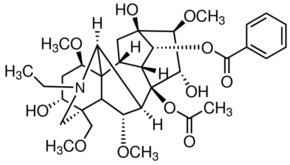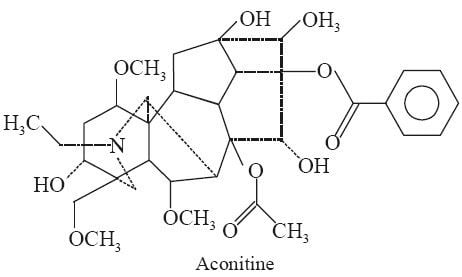Formula C34H47NO11 Appearance solid | Melting point 198 °C | |
 | ||
Aconitine meaning
Aconitine is a toxin produced by the Aconitum plant, also known as devil’s helmet or monkshood. Monkshood is notorious for its toxic properties. In China, aconitine is also used in small doses as an analgesic.
Contents
- Aconitine meaning
- Aconitine queen of poisons 2016scch241 mu5705098
- Uses
- Structure and reactivity
- Synthesis
- Mechanism of action
- Metabolism
- Toxicity
- Diagnosis and treatment
- Famous poisonings
- References

Aconitine queen of poisons 2016scch241 mu5705098
Uses

Aconitine was previously used as an antipyretic and analgesic and still has some limited application in herbal medicine although the narrow therapeutic index makes calculating appropriate dosage difficult.
Structure and reactivity

Aconitine belongs to the family of aconitum alkaloids and is barely soluble in water, but very soluble in organic solvents such as chloroform or diethyl ether. Aconitine is also soluble in mixtures of alcohol and water if the concentration of alcohol is high enough. Aconitine is very toxic due to several reactive groups. The nitrogen in one of the six-membered ring structure can easily form salts and ions. This turns the molecule into a structure with high binding affinity for polar and lipophilic structures (such as cell membranes and receptors) and makes it possible for the molecule to pass the blood-brain barrier. The acetoxyl group at the c8 position can readily be replaced by a methoxy group, by heating aconitine in methanol, to produce a 8-deacetyl-8-o-methyl derivatives. If aconitine is heated in its dry state, it undergoes a pyrolysis to form pyroaconitine((1α,3α,6α,14α,16β)-20-Ethyl-3,13-dihydroxy-1,6,16-trimethoxy-4-(methoxymethyl)-15-oxoaconitan-14-yl benzoate) with the chemical formula C32H43NO9.
Synthesis
Aconitine is synthesized by the monkshood plant via the terpenoid biosynthesis pathway (MEP chloroplast pathway).
Mechanism of action

Aconitine can interact with the voltage-dependent sodium-ion channels, which are proteins in the cell membranes of excitable tissues, such as cardiac and skeletal muscles and neurons. These proteins are highly selective for sodium-ions. They open very fast to depolarize the cell membrane potential, causing the upstroke of an action potential. Normally, the sodium channels close very rapidly, but the depolarization of the membrane potential causes the opening (activation) of potassium channels and potassium-efflux, which results in repolarization of the membrane potential.

Aconitine binds to the receptor at the neurotoxin binding site 2 on the alpha-subunit of the channel protein. This binding results in a sodium-ion channel that stays open longer. Aconitine suppresses the conformational change in the sodium-ion channel from the active state to the inactive state. The membrane stays depolarized due to the constant sodium-influx (which is 10-1000 fold greater than the potassium efflux). As a result, the membrane cannot be repolarized. The binding of aconitine to the channel also leads to the channel to change conformation from the inactive state to the active state at a more negative voltage. In neurons, aconitine increases the permeability of the membrane for sodium-ions, resulting in a huge sodium-influx in the axon terminal. As a result, the membrane depolarizes rapidly. Due to the strong depolarization, the permeability of the membrane for potassium-ions increases fast, resulting in a potassium-reflux to release the positive charge out of the cell. Not only the permeability for potassium-ions but also the permeability for calcium-ions increases as a result of the depolarization of the membrane. A calcium-influx takes place. The increase of the calcium concentration in the cell stimulates the release of the neurotransmitter acetylcholine into the synaptic cleft. Acetylcholine binds to acetylcholine receptors at the postsynaptic membrane to open the sodium-channels there, generating a new action potential.
Research with mouse nerve-hemidiaphragm muscle preparation indicate that at low concentrations (<0,1 microM) aconitine increases the electrically evoked acetylcholine release causing an induced muscle tension. Action potentials are generated more often at this concentration. At higher concentration (0.3–3 microM) aconitine decreases the electrically evoked acetylcholine release, resulting in a decrease in muscle tension. At high concentration (0.3–3 microM), the sodium-ion channels are constantly activated, transmission of action potentials is suppressed, leading to non-excitable target cells or paralysis.
Metabolism
Aconitine is metabolized by cytochrome P450 isozymes (CYPs). There has been research in 2011 in China to investigate in-depth the CYPs involved in aconitine metabolism in human liver microsomes. It has been estimated that more than 90 percent of currently available human drug metabolism can be attributed to eight main enzymes (CYP 1A2, 2C9, 2C8, 2C19, 2D6, 2E1, 3A4, 3A5). The researchers used recombinants of these eight different CYPs and incubated it with aconitine. To initiate the metabolism pathway the presence of NADPH was needed. Six CYP-mediated metabolites (M1–M6) were found by liquid-chromatography, these six metabolites were characterized by mass-spectrometry. The six metabolites and the involved enzymes are summarized in the following table:
Selective inhibitors were used to determine the involved CYPs in the aconitine metabolism. The results indicate that aconitine was mainly metabolized by CYP3A4, 3A5 and 2D6. CYP2C8 and 2C9 had a minor role to the aconitine metabolism, whereas CYP1A2, 2E1 and 2C19 did not produce any aconitine metabolites at all. The proposed metabolic pathways of aconitine in human liver microsomes and the CYPs involved to it are summarized in the table above.
Toxicity
The toxic effects of aconitine have been tested in a variety of animals, including mammals (dog, cat, guinea pig, mouse, rat and rabbit), frogs and pigeons. Depending on the route of exposure, the observed toxic effects were: local anesthetic effect, diarrhea, convulsions, arrhythmias or death. According to a review of different reports of aconite poisoning in humans, the following clinical features were observed:
Progression of symptoms: the first symptoms of aconitine poisoning appear approximately 20 minutes to 2 hours after oral intake and include paraesthesia, sweating and nausea. This leads to severe vomiting, colicky diarrhea, intense pain and then paralysis of the skeletal muscles. Following the onset of life-threatening arrhythmia, including ventricular tachycardia and ventricular fibrillation, death finally occurs as a result of respiratory paralysis or cardiac arrest.
LD50 values for mice are 1 mg/kg orally, 0.100 mg/kg intravenously, 0.270 mg/kg intraperitoneally and 0.270 mg/kg subcutaneously. The lowest published lethal dose (LDLo) for mice is 1 mg/kg orally and 0.100 mg/kg intraperitoneally. The lowest published toxic dose (TDLo) for mice is 0.0549 mg/kg subcutaneously. LD50 value for rats is 0.064 mg/kg intraveneously. The LDLo for rats is 0.040 mg/kg intravenously and 0.250 mg/kg intraperitoneally. The TDLo for rats is 0.040 mg/kg parenterally. For an overview of more test animal results (LD50, LDLo and TDLo) see the following table.
For humans the lowest published oral lethal dose of 28 μg/kg was reported in 1969.
Diagnosis and treatment
For the analysis of the Aconitum alkaloids in biological specimens such as blood, serum and urine, several GC-MS methods have been described. These employ a variety of extraction procedures followed by derivatisation to their trimethylsilyl derivatives. New sensitive HPLC-MS methods have been developed as well, usually preceded by SPE purification of the sample. The antiarrhythmic drug lidocaine has been reported to be an effective treatment of aconitine poisoning of a patient. Considering the fact that aconitine acts as an agonist of the sodium channel receptor, antiarrhythmic agents which block the sodium-channel (Vaughan-Williams' classification I) might be the first choice for the therapy of aconitine induced arrhythmias. Animal experiments have shown that the mortality of aconitine is lowered by tetrodotoxin. The toxic effects of aconitine were attenuated by tetrodotoxin, probably due to their mutual antagonistic effect on excitable membranes. Also Paeoniflorin seems to have a detoxifying effect on the acute toxicity of aconitine in test animals. This may result from alternations of pharmacokinetic behavior of aconitine in the animals due to the pharmacokinetic interaction between aconitine and paeoniflorin. In addition in emergencies to assist someone after calling 911 one can wash the stomach using either tannic acid or powdered charcoal. Heart stimulants such as strong coffee or caffeine may also help.
Famous poisonings
Cleopatra VII of Egypt poisoned her brother Ptolemy XIV with aconitine, to put her son on the throne.
During the Indian Rebellion of 1857, a British detachment were the subject of attempted poisoning with aconitine by the Indian regimental chefs. The plot was thwarted by John Nicholson who, having detected the plot, interrupted the British officers just as they were about to consume the poisoned meal. The chefs refused to taste their own preparation, whereupon it was force fed to a monkey who "expired on the spot". The chefs were hanged.
Aconitine was the poison used by George Henry Lamson in 1881 to murder his brother-in-law in order to secure an inheritance. Lamson had learned about aconitine as a medical student from professor Robert Christison, who had taught that it was undetectable—but forensic science had improved since Lamson's student days.
Aconitine was also made famous by its use in Oscar Wilde's 1891 story "Lord Arthur Savile's Crime". Aconite also plays a prominent role in James Joyce's Ulysses, in which the protagonist Leopold Bloom's father used pastilles of the chemical to commit suicide.
In 1953 aconitine was used by a Soviet biochemist and poison developer Grigory Mairanovsky in experiments with prisoners in the secret NKVD laboratory in Moscow. He admitted killing around 10 people using the poison.
In 2004 Canadian actor Andre Noble died from aconitine poisoning. He accidentally ate some monkshood while he was on a hike with his aunt in Newfoundland.
In 2009 Lakhvir Singh of Feltham, west London, used aconitine to poison the food of her ex-lover (who died as a result of the poisoning) and his current fiancée. Singh received a life sentence for the murder.
